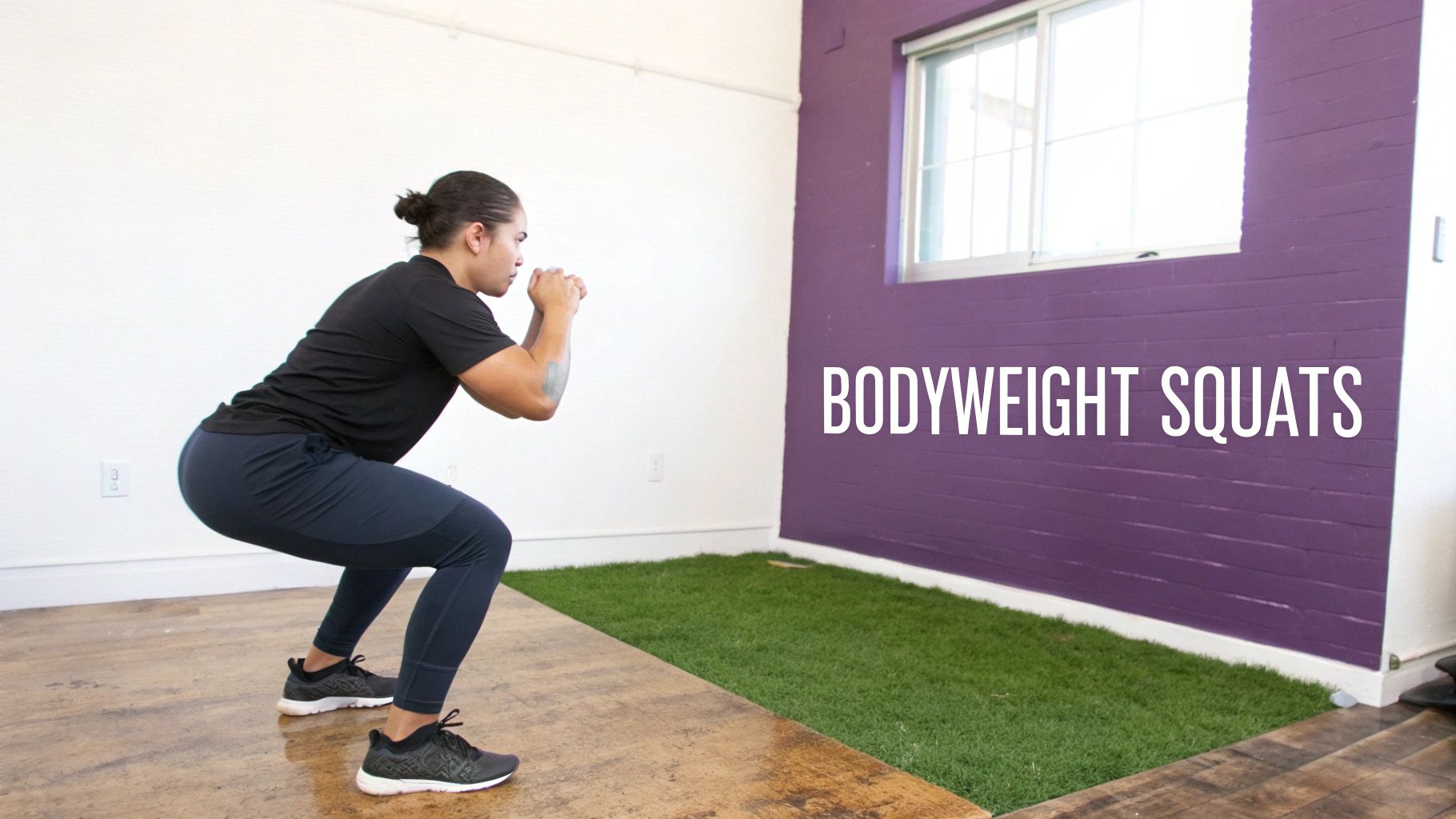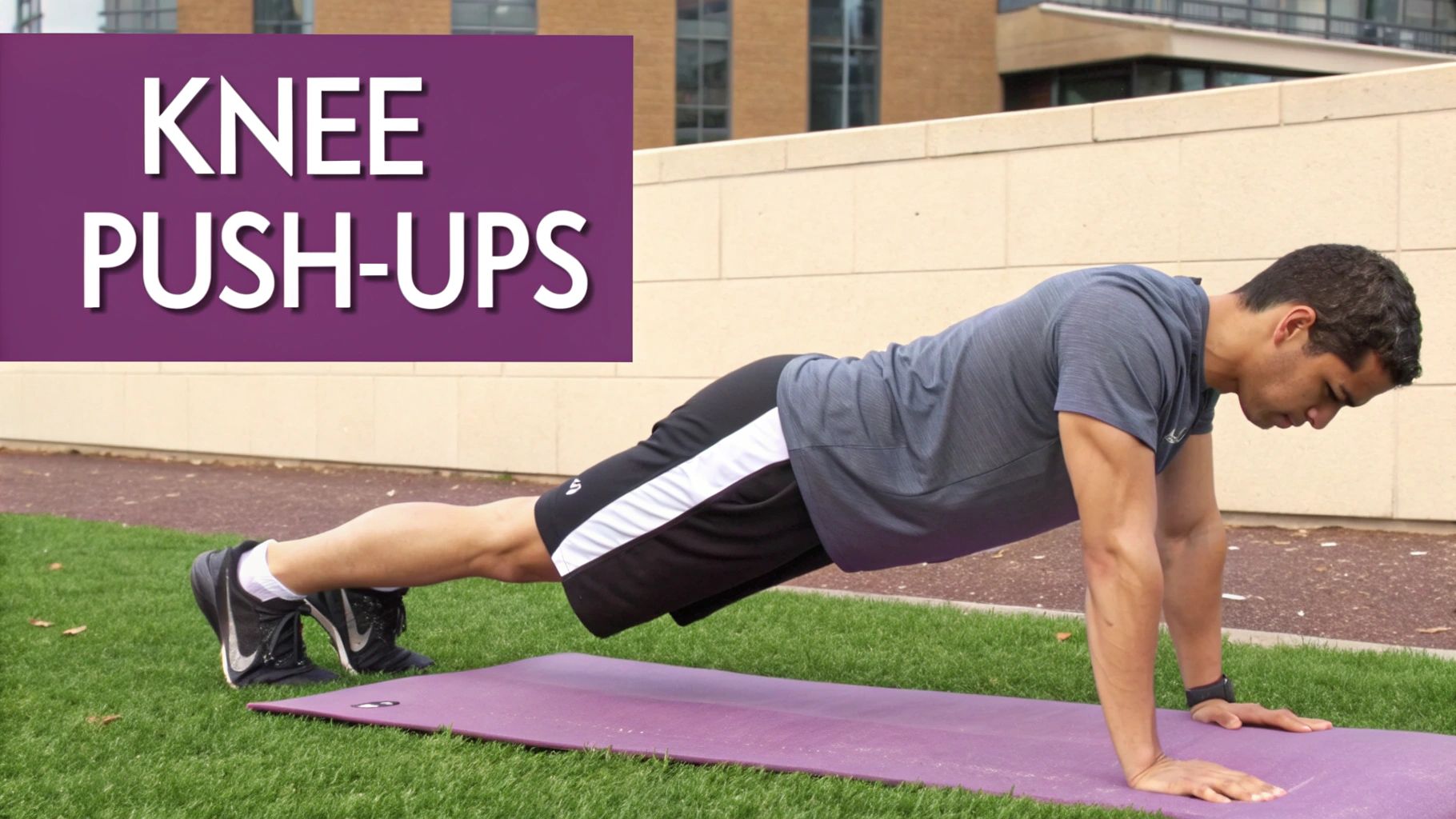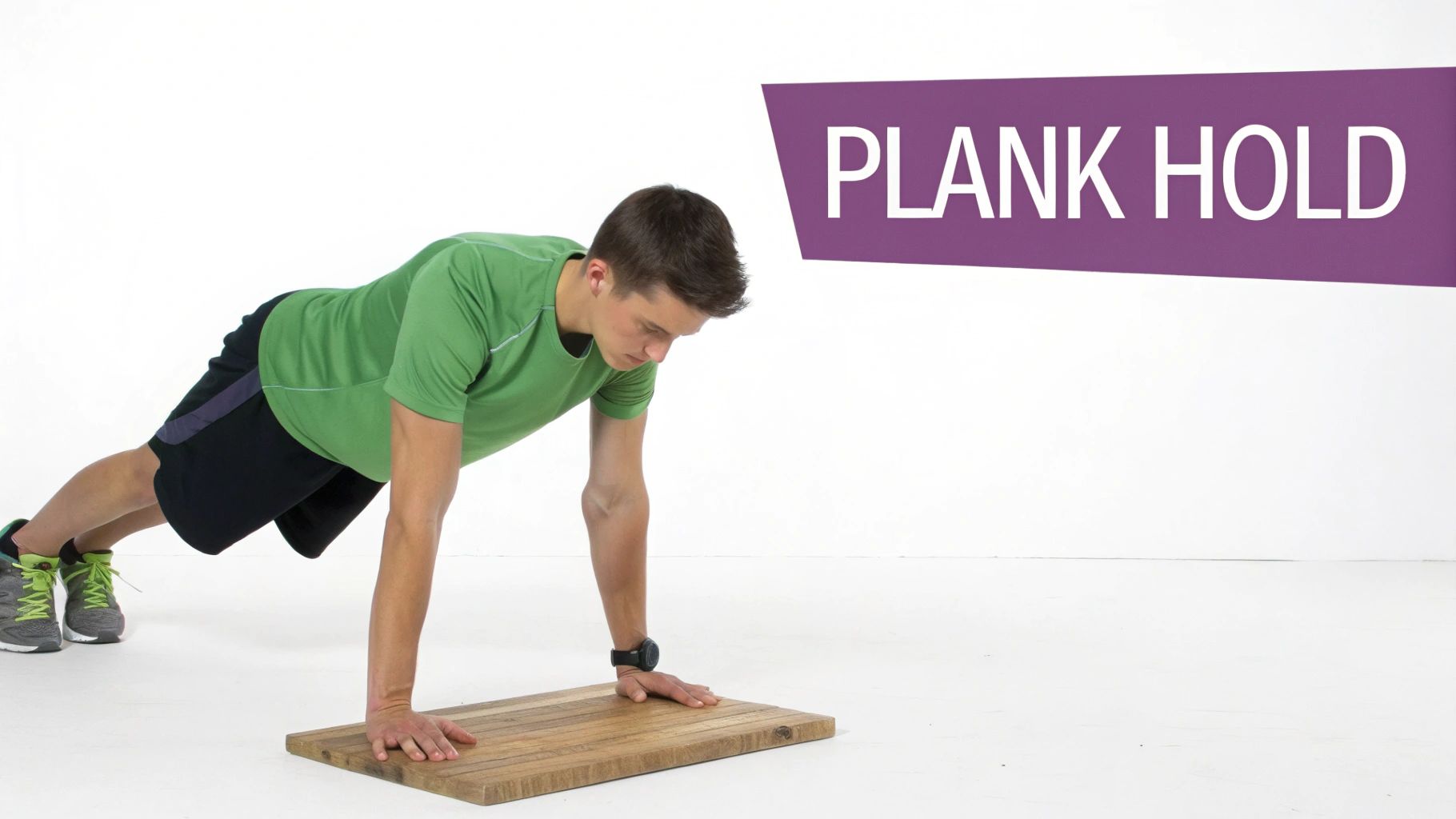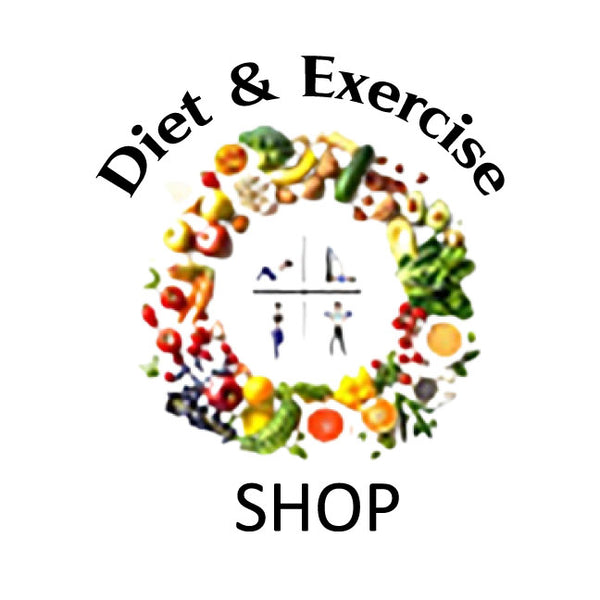
7 Best Exercises for Beginners to Start Your Fitness Journey
Starting a fitness routine can feel overwhelming. With so many workout options, knowing where to begin is often the hardest part. The key is building a solid foundation with exercises that are safe, effective, and easy to learn.
That's why we've compiled this definitive guide to the best exercises for beginners. This is your strategic starting point to build functional strength, improve mobility, and boost your confidence.
Each exercise is broken down into simple steps. We'll show you how to perform foundational movements with perfect form and discuss diet habits to fuel your body for growth and recovery.
1. Walking: The Ultimate Starting Point
Often overlooked, walking is one of the best exercises for beginners. It’s an accessible and fundamental form of cardio that creates a solid foundation for any fitness journey.
Walking is a low-impact exercise, meaning it’s gentle on your joints. This makes it ideal if you are new to physical activity, overweight, or recovering from an injury.
Despite its simplicity, the benefits are profound. Walking improves cardiovascular health, boosts mood, and aids in weight management. A good diet focused on whole foods will enhance these benefits, helping you manage weight more effectively.
How to Get Started with Walking
- Start Small: Begin with a 15-20 minute walk each day. You can break this into two 10-minute walks if that fits your schedule better.
- Focus on Form: Maintain good posture. Keep your head up, looking forward, and relax your neck, shoulders, and back.
- Arm Movement: Swing your arms freely with a slight bend in your elbows. Pumping your arms helps you move at a brisker pace.
Making Progress and Staying Motivated
Once you’re comfortable, start challenging yourself.
- Increase Duration: Add 5 minutes to your daily walk each week.
- Pick Up the Pace: Gradually increase your speed to a brisk pace.
- Vary Your Terrain: Introduce hills or walk on different surfaces like grass or trails to engage different muscles.
To stay motivated, use a fitness app to track your steps. Watching your totals increase can be a powerful motivator. A supportive pair of athletic shoes will also make a world of difference.
2. Bodyweight Squats: The Foundational Strength Builder
Bodyweight squats are a powerhouse exercise essential for building lower body strength. As one of the best exercises for beginners, they target your quadriceps, hamstrings, and glutes.
This exercise mimics sitting down and standing up, making it functional for improving daily mobility. Squats engage multiple muscles at once, promoting muscle growth and improving core stability.
To build muscle with squats, ensure you're eating enough protein. Aim for a protein source with each meal, like chicken, beans, or a protein shake, to help your muscles repair and grow stronger.

How to Get Started with Bodyweight Squats
Mastering correct form is crucial for effectiveness and injury prevention.
- Set Your Stance: Stand with your feet slightly wider than shoulder-width apart, with toes pointing slightly outward.
- Maintain Posture: Keep your chest up and your back straight. Engage your core by pulling your belly button toward your spine.
- The Movement: Hinge at your hips and send them backward as if sitting in a chair. Lower your body until your thighs are parallel to the floor. Push through your heels to return to the start.
Making Progress and Staying Motivated
Once you feel confident, increase the challenge.
- Increase Reps/Sets: Start with 2 sets of 10-15 repetitions. As you get stronger, progress to 3 sets.
- Introduce Pauses: Add a 1-2 second pause at the bottom of the squat to build more strength.
- Vary Your Squat: Try different variations like sumo squats (wide stance) to target muscles differently.
Incorporating squats into a balanced plan is key. You can find a variety of at-home workout routines for beginners that use this foundational exercise.
3. Modified Push-ups: Building Upper-Body Strength
The classic push-up can be intimidating, but modified versions are among the best exercises for beginners to build upper-body and core strength.
Modified push-ups reduce the amount of body weight you lift, making the exercise more accessible. They are a fantastic way to target the chest, shoulders, and triceps while engaging your core.
For best results, pair your upper-body workouts with a diet rich in healthy fats and protein. Foods like avocados, nuts, and lean meats support muscle development and provide sustained energy.

How to Get Started with Modified Push-ups
Find the right variation for your current strength level. The goal is good form.
- Start with the Wall: If a knee push-up is too hard, begin with a wall push-up. Stand facing a wall and place your hands on it.
- Focus on Form: Maintain a straight line from your head to your knees or heels. Keep your core tight to prevent your hips from sagging.
- Control the Movement: Lower your chest towards the surface slowly. Push back up powerfully to the starting position.
Making Progress and Staying Motivated
Once you can complete a few sets comfortably, increase the challenge.
- Increase Repetitions: Aim for 2 sets of 5-10 repetitions. Work your way up to 12-15 reps per set.
- Decrease the Incline: If doing incline push-ups, find a slightly lower surface to increase the difficulty.
- Transition to Knees: Once you master incline push-ups, try them on the floor from your knees. This is the final step before a full push-up.
4. Plank Hold: Building Core Strength from the Ground Up
The plank is a powerhouse isometric exercise and one of the best exercises for beginners for a strong, stable core.
Unlike crunches, the plank engages your abs, back, shoulders, glutes, and legs. It teaches you to brace your core and maintain a neutral spine, a fundamental skill for almost every other exercise.
A strong core is enhanced by a clean diet. Reducing processed foods and sugar can help decrease belly fat, making your core muscles more visible and functional.

How to Get Started with the Plank Hold
Proper form is non-negotiable. It's better to hold a perfect plank for a short time than a sloppy one for longer.
- Start on Your Forearms: Place your forearms on the floor with elbows directly under your shoulders.
- Create a Straight Line: Extend your legs back, resting on your toes. Your body should form a straight line from head to heels.
- Engage Your Core: Pull your belly button in towards your spine. Squeeze your glutes to stabilize your lower body.
Making Progress and Staying Motivated
As you get stronger, increase the challenge.
- Increase Duration: Start with a 20-30 second hold. Add 5-10 seconds to your time each week.
- Modify as Needed: If you can't maintain form, drop to your knees. This modified plank still effectively works your core.
- Try Variations: Once you master the standard plank, try a high plank (on your hands) or add shoulder taps to challenge your stability.
5. Glute Bridges: Awakening Your Strongest Muscles
The gluteal muscles are the largest in your body, and the glute bridge is one of the best exercises for beginners to activate them.
This simple movement targets the glutes, hamstrings, and lower back. It's performed lying on your back, requires no equipment, and is exceptionally safe for your joints.
Glute bridges are effective for counteracting the effects of prolonged sitting. Strengthening this area improves posture and builds a stable core foundation. Pair this with a diet that supports muscle growth to build a stronger posterior chain.
How to Get Started with Glute Bridges
Proper form is crucial for activating the right muscles.
- Start Position: Lie on your back with knees bent and feet flat on the floor, hip-width apart. Rest your arms by your sides.
- The Movement: Press through your heels and squeeze your glutes to lift your hips until your body forms a straight line from shoulders to knees.
- Hold and Lower: Hold the top position for 2-3 seconds, keeping your glutes engaged. Slowly lower your hips back to the start.
Making Progress and Staying Motivated
Once you master the basic glute bridge, you can introduce variations.
- Increase Reps/Sets: Start with 2 sets of 15-20 repetitions. As you get stronger, progress to 3 sets.
- Add a Pause: Increase the hold time at the top to 5-10 seconds.
- Single-Leg Variation: Perform the bridge with one leg extended straight out. This isolates the glute and engages your core.
Proper recovery is key. Discover how to recover faster from workouts to ensure you're ready for your next session.
6. Seated Rows (with resistance band)
Many beginners focus on "push" exercises but neglect "pull" movements. The Seated Row with a resistance band is one of the best exercises for beginners to build back strength and improve posture.
This exercise targets the muscles in your upper back, including the lats, rhomboids, and traps. It's crucial for counteracting the hunched-over posture from sitting at a desk.
Using a resistance band makes this exercise accessible and safe. A balanced diet with adequate protein and micronutrients will support the development of these important postural muscles.
How to Get Started with Seated Rows
The setup is simple. Focus on controlled movement.
- Set Up Your Position: Sit on the floor with legs extended. Loop the band around the arches of your feet. Hold one end in each hand.
- Focus on Form: Sit up tall with a straight back and chest lifted.
- The Pulling Motion: Pull the band towards your torso, squeezing your shoulder blades together. Pause briefly at the peak of the contraction.
Making Progress and Staying Motivated
Once you master the form, increase the challenge.
- Increase Resistance: Progress to a stronger resistance band.
- Slow Down the Reps: Control the return motion slowly to increase time under tension.
- Add Pauses: Hold the squeezed position at the peak of the row for two to three seconds on each repetition.
7. Standing Marching in Place: A Gentle Cardio Boost
Standing marching in place is one of the most underrated and best exercises for beginners. This simple movement mimics walking but can be done anywhere, anytime.
Marching is a zero-impact exercise, placing no stress on your joints. This makes it an exceptional choice for individuals with joint sensitivity or balance concerns.
Combine this with consistent hydration. Drinking enough water throughout the day is crucial for cardiovascular health, energy levels, and overall fitness.
How to Get Started with Marching in Place
Starting is easy. The goal is to establish a rhythm and build endurance.
- Start Slow: Begin by marching for 1-2 minutes at a slow, deliberate pace.
- Focus on Form: Stand tall with your chest up and shoulders back. Engage your core to keep your torso stable.
- Arm Movement: Allow your arms to swing naturally in opposition to your legs, just as you would when walking.
Making Progress and Staying Motivated
Once you feel comfortable, increase the challenge.
- Increase Duration: Gradually add 30-60 seconds to your marching time until you can march for 10-15 minutes straight.
- Pick Up the Pace: Increase your speed to a brisk march to elevate your heart rate.
- Vary Your Movement: Incorporate high-knee marches or add arm movements to engage more muscle groups.
Top 7 Beginner Exercises Comparison
| Exercise | Implementation Complexity 🔄 | Resource Requirements ⚡ | Expected Outcomes 📊 | Ideal Use Cases 💡 | Key Advantages ⭐ |
|---|---|---|---|---|---|
| Walking | Very low (easy, intuitive) | None | Improved cardiovascular health, calorie burn | Beginners, daily activity, low-impact | Accessible anywhere, low impact, stress reduction |
| Bodyweight Squats | Low to moderate (needs form) | None | Lower body strength, mobility, core stability | Strength building, functional fitness | Compound movement, scalable difficulty |
| Modified Push-ups | Moderate (form critical) | None | Upper body & core strength, shoulder stability | Upper body strength progression | Adjustable difficulty, portable |
| Plank Hold | Low to moderate (form focus) | None | Core strength, posture, stability | Core strengthening, injury prevention | High core engagement, low injury risk |
| Glute Bridges | Low (simple technique) | None | Glute strength, hip mobility, lower back support | Rehab, hip activation, beginners | Easy to learn, low back friendly |
| Seated Rows (resistance band) | Moderate (equipment needed) | Resistance band | Upper back strength, posture improvement | Posture correction, office workouts | Portable, low injury risk |
| Standing Marching in Place | Very low (simple movement) | None | Cardiovascular health, coordination | Warm-ups, beginner cardio, small spaces | Very beginner-friendly, balance training |
Putting It All Together: Your Beginner's Action Plan
You now have a toolkit of the seven best exercises for beginners. From squats to planks, you can start your fitness journey with confidence.
You don't need a complex routine or heavy weights to see progress. These exercises build a solid foundation of strength, stability, and endurance. Mastering the proper form is the most important step.
This focus on technique prevents injury and ensures you are effectively engaging the target muscles, paving the way for more advanced exercises down the line.
Your First Steps: Building a Sustainable Routine
The most common mistake is doing too much, too soon. This leads to burnout and lost motivation. Instead, your initial goal should be consistency.
Here’s a simple plan to get started:
- Choose Your Core Exercises: Select 3-4 exercises. A great start is Bodyweight Squats, Modified Push-ups, and the Plank Hold for a full-body workout.
- Schedule Your Workouts: Aim for 2-3 non-consecutive days per week (e.g., Monday, Wednesday, Friday) to allow for recovery.
- Integrate Daily Movement: On "off" days, focus on active recovery like walking or marching in place.
Listening to Your Body and Measuring Progress
Your body is your best guide. Some muscle soreness is normal, but sharp pain is a signal to rest or adjust your form. Don't be discouraged if you can only do a few reps at first. The goal is progress, not perfection.
Celebrate small victories, like holding your plank longer or completing one more push-up. These milestones build momentum.
Combining this effort with proper nutrition will amplify your results, helping you achieve your fitness goals. This foundational approach to the best exercises for beginners is your launchpad to a healthier, stronger you.
Ready to fuel your workouts and maximize your results? The right nutritional support is just as important as your exercise routine. At Diet and Exercise, we offer a range of supplements and resources designed to complement your new fitness plan. Explore our products at Diet and Exercise to find the perfect support for your journey.
